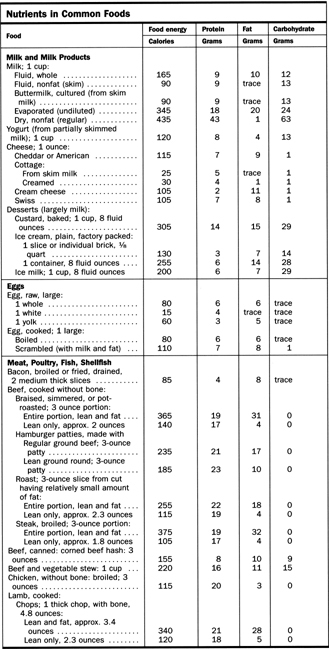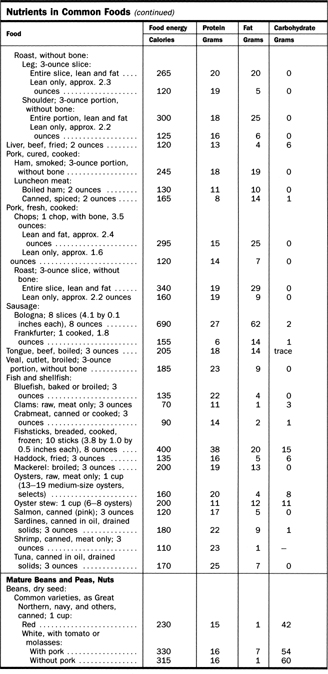Nutrition and Weight Control - Malnutrition
The classic diseases of nutritional deficiency, or malnutrition, such as scurvy and pellagra, are now rare, at least in the United States. The chief reason for their disappearance is the application of scientific knowledge gained in this century of the importance of vitamins and minerals in the diet. Thus most bread is fortified with vitamins and minerals, and in addition, commercial food processing has made it possible for balanced diets of an appealing variety to be eaten all year round.
Many people do not get an adequate diet, either through ignorance or because they simply cannot afford it. A number of food programs have been created to assist them, but unfortunately, the programs don't reach everyone who needs help.
Causes of Malnutrition
Some people, either because of ignorance or food faddism, do not eat a balanced diet even though they can afford to. There are also large numbers of people with nutritional deficiency diseases who can be described as abnormal, at least in regard to eating. Some are alcoholics; others live alone and are so depressed that they lack sufficient drive to feed themselves properly. Combination of any of these factors increase the likelihood of poor nutrition and often lead to health-damaging consequences.
Disease
People can also develop nutritional deficiencies because they have some disease that interferes with food absorption, storage, and utilization, or that causes an increased excretion, usually in the urine, of substances needed for nutrition. These are generally chronic diseases of the gastrointestinal tract including the liver, or of the kidneys or the endocrine glands.
Medications
Nutritional deficiencies can also result from loss of appetite caused by medications, especially when a number of different medications are taken simultaneously. This adverse affect on the appetite is a strong reason for not taking medicines unless told to do so by a physician for a specific purpose.
Most people are not aware of inadequacies in their diet until there are some dramatic consequences. Nor is it easy to recognize the presence of a disorder that might be causing malnutrition. A physician should be consulted promptly when there is a persistent weight loss, especially when the diet is normal. He should also be informed of any changes in the skin, mucous membranes of the mouth or tongue, or nervous system function, because such symptoms can be a warning of dietary deficiency.

The family or friends of a person with a nutritional deficiency can often detect his condition because they become aware of changes in his eating patterns. They can also note early signs of a deficiency of some of the B vitamins, such as cracks in the mucous membranes at the corners of the mouth, or some slowing of intellectual function.
| Food | Food energy | Protein | Fat | Carbohydrate | Calories | Grams | Grams | Grams |
|---|---|---|---|---|---|---|---|---|
| Milk and Milk Products | ||||||||
| Milk; 1 cup: | Fluid, whole | 165 | 9 | 10 | 12 | |||
| Fluid, nonfat (skim) | 90 | 9 | trace | 13 | ||||
| Buttermilk, cultured (from skim milk) | 90 | 9 | trace | 13 | ||||
| Evaporated (undiluted) | 345 | 18 | 20 | 24 | ||||
| Dry, nonfat (regular) .. | 435 | 43 | 1 | 63 | ||||
| Yogurt (from partially skimmed milk); 1 cup | 120 | 8 | 4 | 13 | ||||
| Cheese; 1 ounce: Cheddar or American | 115 | 7 | 9 | 1 | ||||
| Cottage: From skim milk | 25 | 5 | trace | 1 | ||||
| Creamed | 30 | 4 | 1 | 1 | ||||
| Cream cheese | 105 | 2 | 11 | 1 | ||||
| Swiss | 105 | 7 | 8 | 1 | ||||
| Desserts (largely milk): Custard, baked; 1 cup, 8 fluid ounces | 305 | 14 | 15 | 29 | ||||
| Ice cream, plain, factory packed: 1 slice or individual brick, 1/8 quart | 130 | 3 | 7 | 14 | ||||
| 1 container, 8 fluid ounces Ice milk; 1 cup, 8 fluid ounces | 255 200 | 6 6 | 14 7 | 28 29 | ||||
| Eggs | ||||||||
| Egg, raw, large: | ||||||||
| 1 whole | 80 | 6 | 6 | trace | ||||
| 1 white | 15 | 4 | trace | trace | ||||
| 1 yolk | 60 | 3 | 5 | trace | ||||
| Egg, cooked; 1 large: Boiled | 80 | 6 | 6 | trace | ||||
| Scrambled (with milk and fat) | 110 | 7 | 8 | 1 | ||||
| Meat, Poultry, Fish, Shellfish | ||||||||
| Bacon, broiled or fried, drained, 2 medium thick slices | 85 | 4 | 8 | trace | ||||
| Beef, cooked without bone: Braised, simmered, or pot-roasted; 3 ounce portion: Entire portion, lean and fat | 365 | 19 | 31 | 0 | ||||
| Lean only, approx. 2 ounces | 140 | 17 | 4 | 0 | ||||
| Hamburger patties, made with Regular ground beef; 3-ounce patty | 235 | 21 | 17 | 0 | ||||
| Lean ground round; 3-ounce patty | 185 | 23 | 10 | 0 | ||||
| Roast; 3-ounce slice from cut having relatively small amount of fat: Entire portion, lean and fat | 255 | 22 | 18 | 0 | ||||
| Lean only, approx. 2.3 ounces | 115 | 19 | 4 | 0 | ||||
| Steak, broiled; 3-ounce portion: Entire portion, lean and fat | 375 | 19 | 32 | 0 | ||||
| Lean only, approx. 1.8 ounces | 105 | 17 | 4 | 0 | ||||
| Beef, canned: corned beef hash: 3 ounces | 155 | 8 | 10 | 9 | ||||
| Beef and vegetable stew: 1 cup | 220 | 16 | 11 | 15 | ||||
| Chicken, without bone: broiled; 3 ounces | 115 | 20 | 3 | 0 | ||||
| Lamb, cooked: Chops; 1 thick chop, with bone, 4.8 ounces: Lean and fat, approx. 3.4 ounces | 340 | 21 | 28 | 0 | ||||
| Lean only, 2.3 ounces | 120 | 18 | 5 | 0 |

| Food | Food energy | Protein | Fat | Carbohydrate |
|---|---|---|---|---|
| Calories | Grams | Grams | Grams | |
| Roast, without bone: | ||||
| Leg; 3-ounce slice: | ||||
| Entire slice, lean and fat | 265 | 20 | 20 | 0 |
| Lean only, approx. 2.3 ounces | 120 | 19 | 5 | 0 |
| Shoulder; 3-ounce portion, without bone: | ||||
| Entire portion, lean and fat | 300 | 18 | 25 | 0 |
| Lean only, approx. 2.2 ounces | 125 | 16 | 6 | 0 |
| Liver, beef, fried; 2 ounces | 120 | 13 | 4 | 6 |
| Pork, cured, cooked: | ||||
| Ham, smoked; 3-ounce portion, without bone.. | 245 | 18 | 19 | 0 |
| Luncheon meat: | ||||
| Boiled ham; 2 ounces | 130 | 11 | 10 | 0 |
| Canned, spiced; 2 ounces | 165 | 8 | 14 | 1 |
| Pork, fresh, cooked: | ||||
| Chops; 1 chop, with bone, 3.5 ounces: | ||||
| Lean and fat, approx. 2.4 ounces | 295 | 15 | 25 | 0 |
| Lean only, approx. 1.6 ounces | 120 | 14 | 7 | 0 |
| Roast; 3-ounce slice, without bone: | ||||
| Entire slice, lean and fat | 340 | 19 | 29 | 0 |
| Lean only, approx. 2.2 ounces | 160 | 19 | 9 | 0 |
| Sausage: | ||||
| Bologna; 8 slices (4.1 by 0.1 inches each), 8 ounces | 690 | 27 | 62 | 2 |
| Frankfurter; 1 cooked, 1.8 ounces | 155 | 6 | 14 | 1 |
| Tongue, beef, boiled; 3 ounces | 205 | 18 | 14 | trace |
| Veal, cutlet, broiled; 3-ounce portion, without bone | 185 | 23 | 9 | 0 |
| Fish and shellfish: | ||||
| Bluefish, baked or broiled; 3 ounces | 135 | 22 | 4 | 0 |
| Clams: raw, meat only; 3 ounces | 70 | 11 | 1 | 3 |
| Crabmeat, canned or cooked; 3 ounces | 90 | 14 | 2 | 1 |
| Fishsticks, breaded, cooked, frozen; 10 sticks (3.8 by 1.0 by 0.5 inches each), 8 ounces | 400 | 38 | 20 | 15 |
| Haddock, fried; 3 ounces | 135 | 16 | 5 | 6 |
| Mackerel: broiled; 3 ounces | 200 | 19 | 13 | 0 |
| Oysters, raw, meat only; 1 cup (13-19 medium-size oysters, selects) | 160 | 20 | 4 | 8 |
| Oyster stew: 1 cup (6-8 oysters) | 200 | 11 | 12 | 11 |
| Salmon, canned (pink); 3 ounces | 120 | 17 | 5 | 0 |
| Sardines, canned in oil, drained solids; 3 ounces | 180 | 22 | 9 | 1 |
| Shrimp, canned, meat only; 3 ounces | 110 | 23 | 1 | - |
| Tuna, canned in oil, drained solids; 3 ounces | 170 | 25 | 7 | 0 |
| Mature Beans and Peas, Nuts | ||||
| Beans, dry seed: | ||||
| Common varieties, as Great | ||||
| Northern, navy, and others, canned; 1 cup: | ||||
| Red | 230 | 15 | 1 | 42 |
| White, with tomato or molasses: | ||||
| With pork | 330 | 16 | 7 | 54 |
| Without pork | 315 | 16 | 1 | 60 |
Correction of Nutritional Deficiencies
Nutritional deficiencies are among the most easily preventable causes of disease. It is important to realize that even mild deficiencies can cause irreparable damage, particularly protein deprivation in young children, which can result in some degree of mental retardation. Periodic medical checkups for everyone in the family are the best way to make sure that such deficiencies are corrected before they snowball into a chronic disease. In most cases, all that is required is a change of eating habits.

Comment about this article, ask questions, or add new information about this topic: